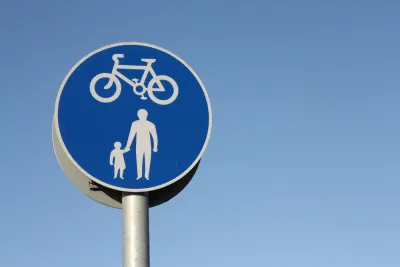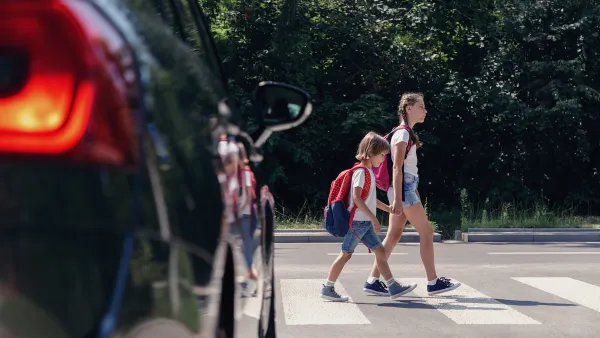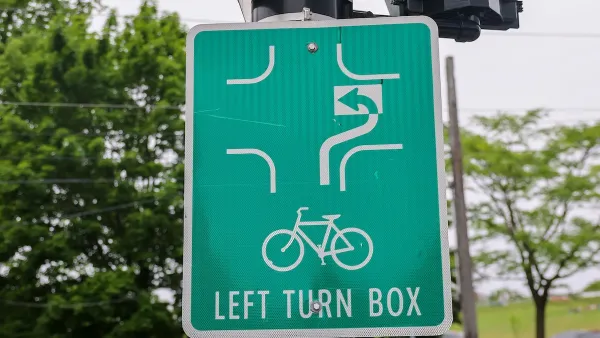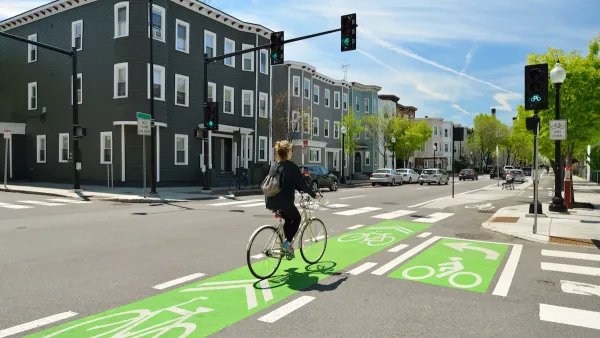One writer argues that rules that prioritize driver safety and ignore pedestrian infrastructure have led to a sharp increase in fatalities on U.S. roads.

Despite the COVID-induced reduction in miles driven in 2020, the number of people killed in vehicle crashes rose by 8% over 2019, with 42,000 people dying on U.S. roads, according to the National Safety Council. Calculated on a per-mile basis, writes Sara Bronin in Bloomberg CityLab, this amounts to a 24% increase in deaths—"the highest year-over-year jump in 96 years."
According to Bronin, "outdated, industry-written laws lock in street designs that encourage excessive speed, and we drive vehicles known to be deadly to non-drivers." While distracted driving and the rise of smartphones plays a small role, other countries have managed to keep their fatalities low. "Compare us with Germany, for example, where a love for speed and widespread cellphone use has not resulted in the death rates we see in the U.S. German traffic deaths fell 12% in 2020, which tracks the country’s 11% decrease in traffic volume."
Bronin writes that this is largely due to the fact that U.S. road design rules prioritize speed. The "Green Book," an influential design manual used widely across federal, state, and local governments, is "written without public input by traffic engineers at the American Association of State Highway and Transportation Officials (AASHTO)." The manual, according to Bronin, "requires lanes that are too wide, which encourages cars to drive faster, and practically ignores pedestrians and bikers. "
Fire codes requiring 20-foot wide unobstructed paths also dominate street design. Additionally, the Manual of Uniform Traffic Control Devices (MUTCD) "recommends setting speed limits that match the 85th percentile of actual free-flowing traffic, rounded up to the nearest 5 miles per hour. In effect, drivers breaking the law by speeding justifies raising speed limits even more."
Lastly, "U.S. safety regulators prioritize the people inside the vehicle, largely ignoring the non-passenger impact of passenger vehicles." Oversized vehicles with "huge frontal surfaces and poor forward vision" which would fail to meet European standards prove more dangerous to pedestrians and other drivers.
Reversing these trends, writes Bronin, calls for changing our regulatory culture. Her proposals for improving design rules include "diversify[ing] the people who codify road design," taking lessons from Complete Streets and other existing programs designed to slow traffic and improve pedestrian safety, increasing public input to design manuals, and prioritizing non-driver safety in the design of roads and vehicles.
FULL STORY: The Rules That Made U.S. Roads So Deadly

Analysis: Cybertruck Fatality Rate Far Exceeds That of Ford Pinto
The Tesla Cybertruck was recalled seven times last year.

National Parks Layoffs Will Cause Communities to Lose Billions
Thousands of essential park workers were laid off this week, just before the busy spring break season.

Retro-silient?: America’s First “Eco-burb,” The Woodlands Turns 50
A master-planned community north of Houston offers lessons on green infrastructure and resilient design, but falls short of its founder’s lofty affordability and walkability goals.

Test News Post 1
This is a summary

Analysis: Cybertruck Fatality Rate Far Exceeds That of Ford Pinto
The Tesla Cybertruck was recalled seven times last year.

Test News Headline 46
Test for the image on the front page.
Urban Design for Planners 1: Software Tools
This six-course series explores essential urban design concepts using open source software and equips planners with the tools they need to participate fully in the urban design process.
Planning for Universal Design
Learn the tools for implementing Universal Design in planning regulations.
EMC Planning Group, Inc.
Planetizen
Planetizen
Mpact (formerly Rail~Volution)
Great Falls Development Authority, Inc.
HUDs Office of Policy Development and Research
NYU Wagner Graduate School of Public Service




























